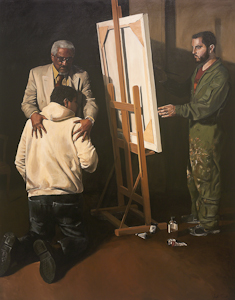 “While he was still a long way off…”
“While he was still a long way off…”
On display at Acton Institute in Grand Rapids is an art exhibit centered on the parable of the prodigal son from Luke 15. “The Father and His Two Sons: The Art of Forgiveness,” was collected by Larry and Mary Gerbens. It includes a 1636 etching by Dutch painter Rembrandt van Rijn, a painting by American artist Robert Barnum, and a reproduction of Rembrandt’s famous “The Return of the Prodigal Son,” among others. Though the works span six countries of origin and five centuries, each portrays a scene from the well-known parable.
Winds rip trees from their roots. Branches are bent backward against the sky. Chaos rules as the wayward son runs toward his father’s farm in Robert Barnum’s Americanized representation. In the distance, an outhouse flies into the air. The son battles gale-force winds to get back to his father. The viewer can almost feel him being tossed about like a leaf.
Rembrandt takes us 30 seconds later in the story. In his 1636 etching, the son kneels at his father’s feet, but his father reaches to raise him up. The stone steps they stand on are firmly attached to the ground. The foundations of the house are secure. We can see great compassion in the father’s embrace.
Of course, the older brother, who has never rebelled, feels jealous and marginalized. In the Rembrandt, he leans out of the window and looks directly at the viewer as if to appeal to an unbiased fourth party.
And, after the homecoming, his self-righteousness is still palpable. An etching by James Tissot (“No IV- The Fatted Calf”, 1881) shows him complaining that his father has never honored him in the way that he now honors his younger brother. Larry Gerbens pointed out that the older son is just as distant from the family as the younger is; another Tissot etching shows him daydreaming while his brother viciously takes leave of his father.
Larry came to Acton on Wednesday and spoke about what inspired him to start collecting. In the mid-1990’s, he stumbled across a book by Henri Nouwen, The Return of the Prodigal Son. After several days contemplating Rembrandt’s famous painting by the same name, Nouwen wrote a book reflecting on his experiences. He writes:
I have been led to an inner place where I had not been before. It is the place within me where God has chosen to dwell. It is the place where I am held safe in the embrace of an all-loving Father who calls me by name and says, ‘You are my beloved son, on you my favor rests.’ It is the place where I can taste the joy and the peace that are not of this world.
The book touched Larry deeply and he felt called to collect art that visually portrayed this parable for the glory of God. Larry said that he once denied Christ’s forgiveness in his life. A friend asked what drew him to the parable of the prodigal son; Larry mumbled something and commented on the weather. Now, he witnesses to the power of God’s grace in his life whenever he speaks about the collection. He said that the reason he finds art about the prodigal son so compelling is simple: God has given him grace and forgiveness many, many times.
On the larger context of the parables in Luke 15, see Jordan Ballor’s commentary “Work and Prayer: Of Coins, Sheep, and Men,” from 2011.

